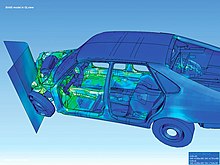|
Environmental engineering science Environmental engineering science (EES) is a multidisciplinary field of engineering science that combines the biological, chemical and physical sciences with the field of engineering. This major traditionally requires the student to take basic engineering classes in fields such as thermodynamics, advanced math, computer modeling and simulation and technical classes in subjects such as statics, mechanics, hydrology, and fluid dynamics. As the student progresses, the upper division elective classes define a specific field of study for the student with a choice in a range of science, technology and engineering related classes.[1] Difference with related fields As a recently created program, environmental engineering science has not yet been incorporated into the terminology found among environmentally focused professionals. In the few engineering colleges that offer this major, the curriculum shares more classes in common with environmental engineering than it does with environmental science. Typically, EES students follow a similar course curriculum with environmental engineers until their fields diverge during the last year of college. The majority of the environmental engineering students must take classes designed to connect their knowledge of the environment to modern building materials and construction methods. This is meant to direct the environmental engineer into a field where they will more than likely assist in building treatment facilities, preparing environmental impact assessments or helping to mitigate air pollution from specific point sources. Meanwhile, the environmental engineering science student will choose a direction for their career. From the range of electives they have to choose from, these students can move into a fields such as the design of nuclear storage facilities, bacterial bioreactors or environmental policies. These students combine the practical design background of an engineer with the detailed theory found in many of the biological and physical sciences. Description at universitiesStanford University
UC BerkeleyThe College of Engineering at UC Berkeley defines Environmental Engineering Science, including the following:[1]
Massachusetts Institute of TechnologyAt MIT, the major is described in their curriculum, including the following:[2]
University of FloridaThe College of Engineering at UF defines Environmental Engineering Science as follows:
 Lower division courseworkLower division coursework in this field requires the student to take several laboratory-based classes in calculus-based physics, chemistry, biology, programming and analysis. This is intended to give the student background information in order to introduce them to the engineering fields and to prepare them for more technical information in their upper division coursework. Upper division coursework The upper division classes in Environmental Engineering Science prepares the student for work in the fields of engineering and science with coursework in subjects including the following:[1]
ElectivesProcess engineeringOn this track, students are introduced to the fundamental reaction mechanisms in the field of chemical and biochemical engineering.
Resource engineeringFor this track, students take classes introducing them to ways to conserve natural resources. This can include classes in water chemistry, sanitation, combustion, air pollution and radioactive waste management.
GeoengineeringThis examines geoengineering in detail.
EcologyThis prepares the students for using their engineering and scientific knowledge to solve the interactions between plants, animals and the biosphere.
BiologyThis includes further education about microbial, molecular and cell biology. Classes can include cell biology, virology, microbial and plant biology
PolicyThis covers in more detail ways the environment can be protected through political means. This is done by introducing students to qualitative and quantitative tools in classes such as economics, sociology, political science and energy and resources.
Post graduation workThe multidisciplinary approach in Environmental Engineering Science gives the student expertise in technical fields related to their own personal interest. While some graduates choose to use this major to go to graduate school,[1] students who choose to work often go into the fields of civil and environmental engineering, biotechnology, and research. However, the less technical math, programming and writing background gives the students opportunities to pursue IT work and technical writing. See also
Notes
References"MIT Course Catalog: Department of Civil and Environmental Engineering." Massachusetts Institute of Technology. <http://web.mit.edu/catalogue/degre.engin.civil.shtml>. 2008-2009 Announcement. Brochure. Berkeley, 2008. Engineering Announcement 2008-2009. University of California, Berkeley. <https://web.archive.org/web/20081203005457/http://coe.berkeley.edu/students/EngAnn08.pdf>. External links |










